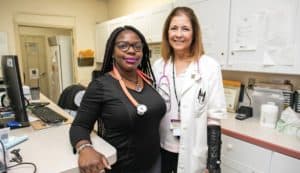By Kathy Leonard, Nurse Practitioner Fight for More Freedom, on washingtonexaminer.com
Cathy Hampton’s job as a nurse practitioner is similar in a lot of ways to that of a doctor. She can prescribe medication, order tests, refer patients to specialists, and manage treatments.
Hampton is employed half of her workweek just 1.5 miles north of the Capitol, at So Others Might Eat, or SOME, an organization for low-income people that provides food, housing, job training, counseling, and a medical clinic. Hampton, who has been a nurse practitioner for 10 of her 25 years as a nurse, can walk her patients down the hall to meet with social workers or help them with other services they need.
“What I do isn’t very different from what a physician does at this point,” Hampton said. “I treat opiate addiction, I treat the major chronic diseases, I refer out if I need to. That’s really what my physician colleagues do as well.”
This kind of arrangement, in which patients are seen by a nurse with a graduate degree, is becoming more common for patients. For Cathy Grant, another nurse practitioner who works in rural Pennsylvania, educating new patients about how she can help them is part of the job, too.
But nurse practitioners don’t have the same authorities in every state. In Washington, D.C., nurse practitioners can set up their own practices, but Pennsylvania and 27 other states have restrictions on the practice. In most states, nurse practitioners aren’t allowed to carry out their jobs without getting sign-off from a doctor. They have to work under an existing physician practice, meaning that every part of their job, from providing physicals to prescribing medications, has an extra layer of oversight.
While doctor groups see this arrangement as a necessary part of delivering care, it’s something nurse practitioner groups hope to change. If they are allowed to operate on their own, they say, they can help reduce healthcare spending, improve access to medical care, and address the doctor shortage at a time when the U.S. population is aging and demand for healthcare is growing.
“It is true physicians go to more school, have more training, and bring a different perspective, but the evidence suggests nurse practitioners are able to provide care that is the same, if not better, quality,” said Kristin Wikelius, who leads policy at United States of Care, a healthcare nonprofit.
Tay Kopanos, vice president of state government affairs at the American Association of Nurse Practitioners, said the laws are outdated and prevent nurse practitioners from doing the job they were trained for.
“It’s like having a driver’s license but then making it illegal for you to drive unless you have a permission slip from someone in your neighborhood,” she said.
Doctor groups oppose the changes, saying that nurse practitioners don’t have the training or education needed to help patients get the best quality of care on their own. They conclude that patients can benefit most when medical providers are led by doctors who address patients’ needs with a team of specialists.
“Nurse practitioners are valuable members of this team, and patients win when each member of their healthcare team plays the role they are educated and trained to play,” said the American Medical Association, the nation’s largest doctor group.
Doctor groups note that their members spend four years in medical school followed by three to seven years of residency, a training they say has put them in the best position to diagnose complex medical conditions and develop treatment plans specific to patients’ circumstances.
The turf dispute in states is occurring as the Association of American Medical Colleges reports the doctor shortage is expected to reach between 46,900 and 121,900 by 2032. Physician groups, however, contend that there are other solutions, such as loan forgiveness, increasing residency slots in medically underserved areas, and expanding class sizes.
“Every patient deserves access to the highest level of training they can get,” said Dr. Danae Powers, president of the Pennsylvania Medical Society, which represents doctors in the commonwealth. “If you’re going to take something off the doctors’ plate, don’t make it the time with the patients.”
Powers said doctors are suffering from burnout because they spend so much time filling out forms, calling insurers, trying to get tests done, and dealing with unwieldy electronic medical record-keeping systems. Those problems, she said, are what lawmakers should be looking to address.
States are slowly moving in the direction of expanding freedoms for nurse practitioners, though large states such as California, Texas, and Florida still have the restrictions. A hodgepodge of advocates, from AARP to conservative think tanks, have supported the changes.
Pennsylvania is one large state where lawmakers are considering relaxing medical licensing restrictions. There, a nurse practitioner has to have a business contract with two doctors to be able to practice. The issue has come up in past sessions and passed the state Senate, but floundered in the House.
“We are looking to improve the quality of care,” said Adele Caruso, president of the Pennsylvania Coalition of Nurse Practitioners. “We are qualified providers, and we have shown that time and time again.”
The Association of American Medical Colleges doesn’t actively oppose or support legislation that would allow nurse practitioners to be more independent, saying it depends on where patients live and what the circumstances are. The best models, said Dr. Janis Orlowski, AAMC’s chief health care officer, are where different providers are working together.
“We want to be very supportive of nurse practitioners and the care they can provide, and we want to work with them as part of our interprofessional team,” Orlowski said. “On the other hand, we believe there are some services only a physician can provide.”

